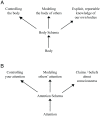A conceptual framework for consciousness
- PMID: 35486693
- PMCID: PMC9170028
- DOI: 10.1073/pnas.2116933119
A conceptual framework for consciousness
Abstract
This article argues that consciousness has a logically sound, explanatory framework, different from typical accounts that suffer from hidden mysticism. The article has three main parts. The first describes background principles concerning information processing in the brain, from which one can deduce a general, rational framework for explaining consciousness. The second part describes a specific theory that embodies those background principles, the Attention Schema Theory. In the past several years, a growing body of experimental evidence-behavioral evidence, brain imaging evidence, and computational modeling-has addressed aspects of the theory. The final part discusses the evolution of consciousness. By emphasizing the specific role of consciousness in cognition and behavior, the present approach leads to a proposed account of how consciousness may have evolved over millions of years, from fish to humans. The goal of this article is to present a comprehensive, overarching framework in which we can understand scientifically what consciousness is and what key adaptive roles it plays in brain function.
Keywords: attention; awareness; consciousness; evolution; theory of mind.
Conflict of interest statement
The author declares no competing interest.
Figures

References
-
- Dennett D. C., Consciousness Explained (Little, Brown, and Co., Boston, MA, 1991).
-
- Nisbett R. E., Wilson T. D., Telling more than we can know—Verbal reports on mental processes. Psychol. Rev. 84, 231–259 (1977).
-
- Gazzaniga M. S., The Bisected Brain (Appleton Century Crofts, New York, 1970).
-
- Frankish K., Illusionism as a theory of consciousness. J. Conscious. Stud. 23, 1–39 (2016).
-
- Graziano M. S. A., Rethinking Consciousness: A Scientific Theory of Subjective Experience (W. W. Norton, New York, 2019).
Publication types
MeSH terms
LinkOut - more resources
Full Text Sources
Miscellaneous

